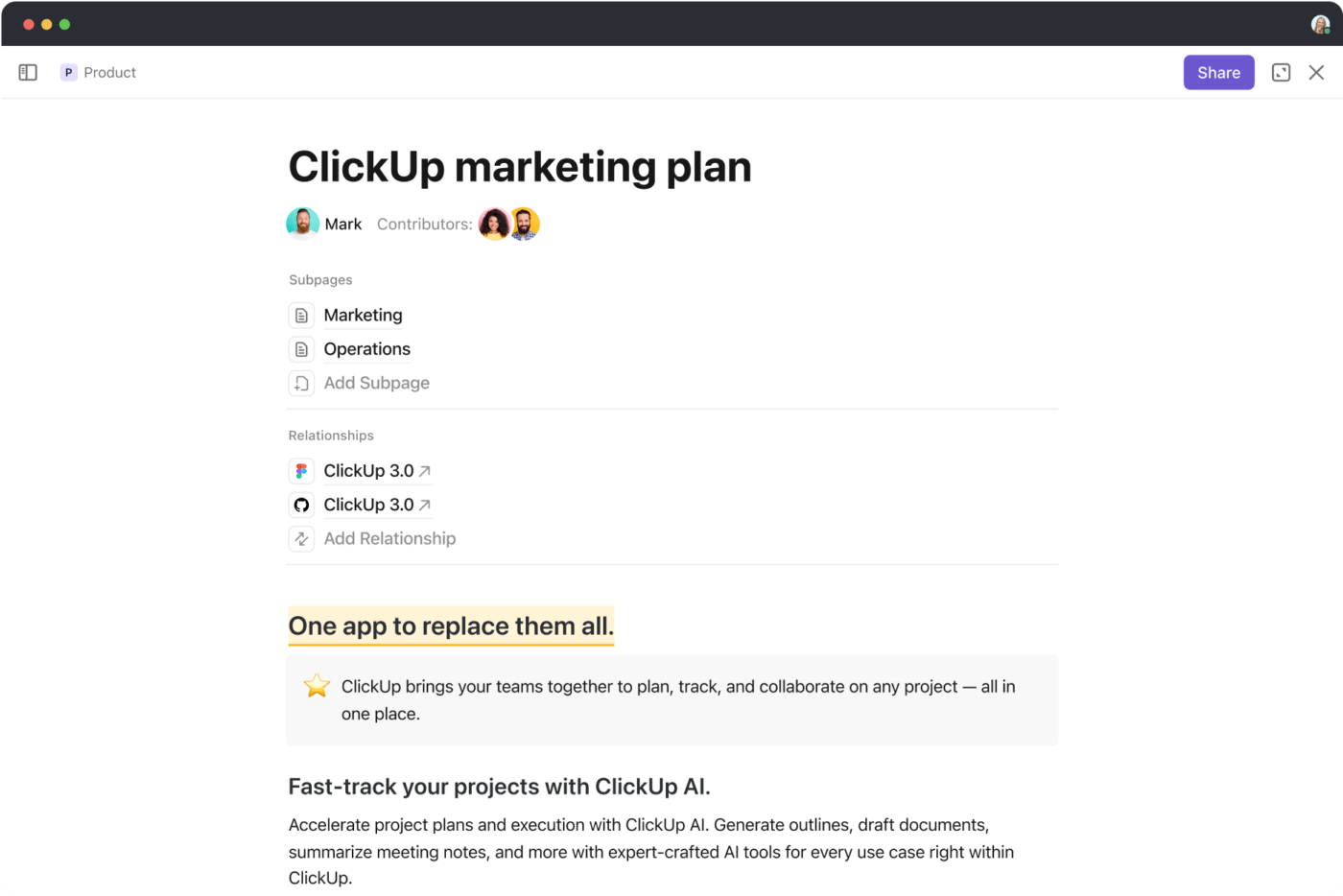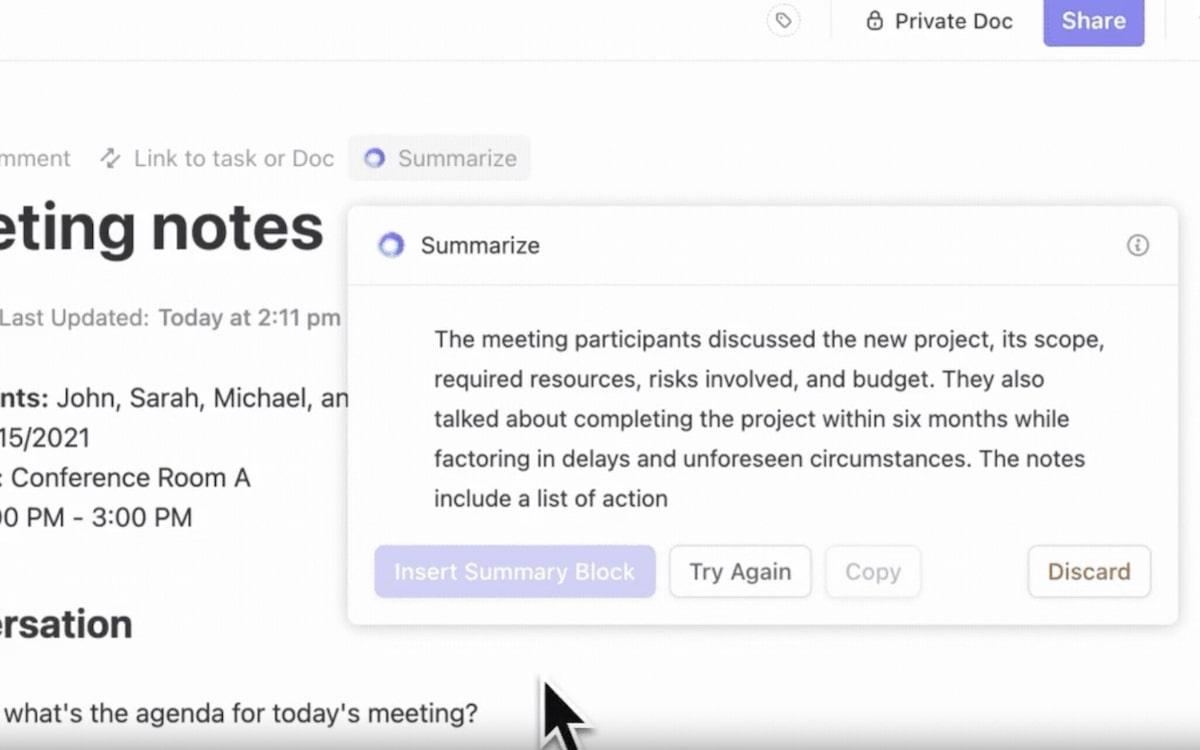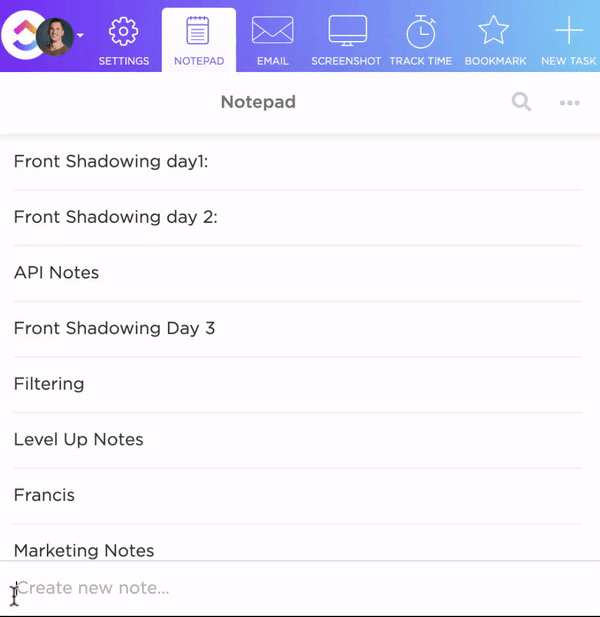تعد الاجتماعات الجيدة أساس العمل الجماعي الناجح، سواء كنت تعمل على مشروع أو تطور استراتيجيات أو تتولى مهام العمل اليومية. ومع ذلك، لا تكون الاجتماعات مهمة إلا إذا تذكرنا الأفكار التي اكتسبناها واستخدمناها. 🌟
تدوين ملاحظات الاجتماعات طريقة مفيدة لتسجيل جميع النقاط المهمة والمهام والقرارات لرجوع إليها في المستقبل.
في هذا الدليل، سنناقش أهمية تدوين الملاحظات كميزة أساسية في مجال الأعمال، وكيف تختلف عن المحاضر الرسمية، وبعض التقنيات المفيدة حول كيفية تدوين ملاحظات الاجتماعات. ستكتشف أيضًا كيف يمكن لأدوات مثل ClickUp تبسيط هذه العملية، خاصة لمديري المشاريع وقادة الفرق. 🚀
ما هي ملاحظات الاجتماعات؟
ملاحظات الاجتماعات هي ملخصات سريعة للنقاط الرئيسية التي تمت مناقشتها خلال الاجتماع وتختلف عن محاضر الاجتماعات الرسمية. على عكس المحاضر الرسمية، لا تكون صيغتها مفصلة أو صارمة، لذا فهي لا تعتبر بالضرورة سجلاً رسمياً. بدلاً من ذلك، تهدف الملاحظات إلى تسجيل جدول أعمال الاجتماع والنقاط الرئيسية والإجراءات والخطوات وجدول الأعمال للخطوات التالية بمرونة. وهي قصيرة ومخصصة للاستخدام الداخلي، وتساعد أعضاء الفريق على البقاء على اتساق. 🔑
ملاحظات الاجتماعات مقابل محاضر الاجتماعات
لفهم أهمية هذه الاختلافات، من الضروري فهم الفرق بين ملاحظات الاجتماعات ومحاضر الاجتماعات:
- ملاحظات الاجتماع: قم بتمييز النقاط الرئيسية والمهام المطلوبة والنقاط الأساسية. تكون هذه الملاحظات غير رسمية ومباشرة وعادة ما يتم مشاركتها داخل الفرق لإبقاء المشاركين في الاجتماع على نفس الصفحة
- محاضر الاجتماعات: قدم ملخصًا تفصيليًا للمناقشات والقرارات ومساهمات المشاركين. وهي بمثابة سجلات رسمية، وغالبًا ما تكون مطلوبة لاجتماعات مجلس الإدارة أو الامتثال
أهمية تدوين ملاحظات الاجتماعات بفعالية
يعتمد نجاح الاجتماع على جودة المناقشات وفعالية التوثيق والمتابعة. 📌دعونا نتعمق في الأسباب التي تجعل تدوين ملاحظات الاجتماعات بشكل منتج من خلال عملية تدوين قوية أمرًا بالغ الأهمية:
- الوضوح والتركيز: مصممة لتوضيح الخطوات الأساسية والتفاصيل والمسؤوليات، مما يساعد الفرق على تجنب سوء الفهم أثناء المناقشات
- تحسين المساءلة: تم تكوينه لتتبع ملكية المهام، مما يضمن أن يظل الجميع مسؤولين ويلتزموا بالمواعيد النهائية
- الذاكرة والمرجع: يعمل كمرجع مناسب لمنع الالتباس وتوضيح الاتفاقات الشفوية من نوع "قال هو، قالت هي" بين أعضاء الفريق
- إدارة الوقت: تبسيط المناقشات من خلال تقليل الحاجة إلى إعادة مناقشة الموضوعات التي تمت مناقشتها سابقًا، مما يوفر الوقت في الاجتماعات المستقبلية
دور ملاحظات الاجتماعات في إدارة المشاريع
في إدارة المشاريع، يعد تدوين ملاحظات الاجتماعات أمرًا ضروريًا لمتابعة المهام والمراحل المهمة. تضمن الملاحظات المنظمة جيدًا التواصل الواضح وعدم إغفال أي شيء، خاصة في المشاريع المعقدة التي تضم عدة أعضاء من الفريق. دعونا نلقي نظرة على الدور الذي يلعبه تدوين الملاحظات أثناء اجتماعات الفريق في إنجاح المشاريع:
- توثيق المعالم: غالبًا ما يكشف توثيق المعالم عن وجود علاقة وثيقة بين القرارات الرئيسية المتخذة في اجتماعاتك والمعالم ذات الصلة بالمشروع. تساعد تدوين الملاحظات على تتبع القرارات المتخذة، مما يسهل على المديرين والقادة متابعة التقدم المحرز في تنفيذها
- تتبع بنود العمل: يضمن تسجيل بنود العمل أن يقوم مديرو المشاريع أو الأشخاص المعينون لتدوين الملاحظات بتدوين الملاحظات لتعيين المهام بوضوح وأن يعرف الجميع مسؤولياتهم
- ضمان التوافق: الحفاظ على ملاحظات الاجتماعات للمناقشات وخطط العمل يضمن أن جميع المشاركين على دراية بأهداف المشروع وغاياته
ما يجب تضمينه في ملاحظات اجتماعاتك
تحتاج إلى تنسيق منظم للحصول على أفضل ملاحظات الاجتماعات التي تعكس جدول الأعمال.
تأكد دائمًا من تضمين العناصر التالية عند تدوين الملاحظات:
- التاريخ والوقت: حدد موعد انعقاد الاجتماع. هذا مفيد لتتبع المحادثات ومراجعة الجداول الزمنية
- المشاركون: قم بتدوين أسماء جميع الحاضرين حتى تعرف بالضبط من كان حاضرًا ومن قد يحتاج إلى بعض المعلومات لاحقًا
- جدول الأعمال: راجع جدول أعمال الاجتماع وقم بمواءمة ملاحظاتك مع الموضوعات التي تمت مناقشتها في اجتماع الفريق
- النقاط الرئيسية: لخص النقاط الرئيسية لكل بند من بنود جدول الأعمال. لا يجب أن تكون هذه ملخصات دقيقة؛ يكفي ذكر الأفكار الرئيسية
- القرارات: قم بتوثيق قرارات الاجتماع ومن اتخذها
- بنود العمل: قم بتمييز بنود العمل لتوضيح مهام كل عضو في الفريق والمواعيد النهائية والمتطلبات
- الخطوات التالية: قم بتضمين أي إجراءات متابعة أو حدد موعدًا للاجتماع التالي
تقنيات تدوين ملاحظات الاجتماعات بفعالية
جرب تقنيات مختلفة لتدوين الملاحظات لتجد ما يناسبك ويناسب هيكل الاجتماع. تساعدك هذه الطرق على تنظيم ملاحظاتك وتحسينها. ✅
نظام كورنيل لتدوين الملاحظات

نظم ملاحظاتك بفعالية باستخدام طريقة كورنيل لتدوين الملاحظات. تتضمن هذه الطريقة تقسيم دروسك أو اجتماعاتك إلى أقسام للملاحظات والملاحظات الموجزة والملخصات؛ مما يسهل مراجعة النقاط الأساسية وحفظها. طريقة كورنيل شائعة في المدارس، ولكنها أيضًا ممتازة للاجتماعات الشخصية والافتراضية. تتضمن هذه الطريقة تقسيم الصفحة إلى ثلاثة أقسام:
- عمود الإشارات: هذا العمود الضيق الموجود على اليسار مخصص للكلمات المفتاحية أو الإشارات
- ملاحظات: القسم الرئيسي مخصص للملاحظات التفصيلية
- ملخص: ملخص لأهم النقاط في أسفل الصفحة
تسجل هذه الطريقة نقاط النقاش لكل مشارك في غرفة الاجتماعات لأنك تقوم بفرز المعلومات فور ظهورها، مما يجعلها مثالية للتفكير في المناقشات لاحقًا.
رسم الخرائط الذهنية

طريقة Mind Mapping هي طريقة مرئية لتنظيم ملاحظاتك من خلال ربط الأفكار بطريقة منظمة. هذه الطريقة ممتازة خلال جلسات العصف الذهني أو المحادثات الإبداعية، حيث تترابط الأفكار مع بعضها البعض.
تحصل كل فكرة على "عقدة" فريدة توضح الروابط بين الموضوعات عن طريق رسم خطوط. الخرائط الذهنية معقدة، ولكنها مفيدة لرؤية كيفية ارتباط كل شيء في الاجتماع وترابطه معًا.
طريقة المخطط

تنظم طريقة المخطط التفصيلي المعلومات عن طريق سرد الموضوعات الرئيسية كعناوين وتبويب النقاط الفرعية تحتها. هذه الطريقة مثالية للاجتماعات ذات الهيكل الواضح، حيث تسهل فرز المعلومات إلى مجموعات منطقية.
طريقة الرسم البياني

يساعد استخدام طريقة الرسوم البيانية عندما يكون لديك الكثير من المعلومات للمقارنة.
يمكنك إنشاء جدول بحيث يمثل كل عمود فئة مختلفة، مثل المهمة والمسؤول والموعد النهائي. ثم يغطي كل صف نقطة مختلفة خلال الاجتماع.
هذه الطريقة فعالة للغاية لإدارة الاجتماعات التي تتطلب مراقبة عدة مقاييس أو بنود عمل.
طريقة الجملة

تتضمن طريقة الجملة كتابة كل نقطة في جملة كاملة. تتيح هذه الطريقة تسجيل جميع التفاصيل، ولكنها قد تكون صعبة في الاجتماعات السريعة. الوضع المثالي هو الاجتماعات غير الرسمية حيث تتدفق المحادثة بحرية، وينتقل الجميع من موضوع إلى آخر.
نصائح لتدوين الملاحظات بفعالية
اختيار الطريقة هو البداية. ومع ذلك، لإتقان تدوين الملاحظات بفعالية، تحتاج إلى مهارات واستراتيجيات أساسية لتسجيل المعلومات الصحيحة. ✏️
مهارات الاستماع
انتبه واستمع بانتباه!
الأمر يتعلق باختيار النقاط الرئيسية بدلاً من تدوين كل كلمة. عليك التركيز على ما هو مهم وتلخيصه. دعنا نركز على النقاط الرئيسية والقرارات والإجراءات بدلاً من محاولة تدوين كل كلمة.
تحديد النقاط الرئيسية
ليس كل ما يُناقش في الاجتماع ضروريًا. من الضروري تعلم كيفية تدوين الملاحظات في الاجتماع وتحديد النقاط المهمة. عادةً ما تكون هذه هي اللحظات التي يتخذ فيها الأفراد القرارات أو يوزعون المهام أو يقدمون معلومات جديدة. انتبه إلى اللحظات التي يكرر فيها المشاركون نقاطًا معينة أو يؤكدون عليها، لأنها على الأرجح مهمة.
استخدام الاختصارات والرموز
جرب استخدام الاختصارات والرموز للبقاء على اطلاع أثناء الاجتماع. على سبيل المثال:
- AI للمهام المطلوب تنفيذها
- D للقرارات
- → للإشارة إلى متابعة
- ? للأسئلة التي تريد متابعتها لاحقًا
يوفر استخدام الاختصارات الوقت ويساعدك على مواكبة المناقشات السريعة وتدوين ملاحظات الاجتماعات بشكل أفضل.
تنظيم الملاحظات
من الضروري تنظيم ملاحظاتك أثناء العمل. استخدم العناوين والنقاط والمسافات البادئة لتقسيم الموضوعات والمهام المختلفة. سيساعدك هذا الأسلوب في الحفاظ على ملاحظاتك واضحة وسهلة المتابعة أثناء الاجتماع وبعده.
تلخيص المناقشات
بمجرد انتهاء الاجتماع، خذ بعض الوقت لمراجعة النقاط الرئيسية. يساعد إضافة ملخص سريع في نهاية ملاحظاتك على توضيح الأمور وتجنب أي لبس عند الرجوع إليها.
استخدام الأداة المناسبة لتدوين ملاحظات الاجتماعات
على الرغم من أن الملاحظات المكتوبة بخط اليد تؤدي الغرض، إلا أن الأدوات الرقمية تجعل تسجيل ملاحظات الاجتماعات وتنظيمها ومشاركتها أمرًا سهلاً. من بين العديد من برامج تدوين ملاحظات الاجتماعات ومحاضر الاجتماعات المتاحة، يعد ClickUp أداة رقمية رائعة لتدوين الملاحظات ومليئة بالميزات التي تساعد في تسهيل العملية. 🔧
كيف يمكن استخدام ClickUp لتدوين ملاحظات الاجتماعات
يؤدي استخدام الأداة المناسبة لتدوين ملاحظات الاجتماعات إلى تعزيز سير عملك. ClickUp هي منصة إنتاجية قوية تجعل تدوين الملاحظات أكثر سهولة وتعاونًا وكفاءة. سواء كنت تعمل بمفردك أو تتعاون مع مجموعة، فإن ClickUp تدعمك بأدوات تحافظ على ملاحظات اجتماعاتك منظمة وقابلة للتنفيذ ومتزامنة تمامًا مع مهامك ومشاريعك.
ClickUp Docs لتدوين الملاحظات بشكل تعاوني والتحديثات في الوقت الفعلي

استخدم ClickUp Docs لتدوين الملاحظات معًا في الوقت الفعلي، مما يتيح لجميع أعضاء الفريق المشاركة وإضافة أفكارهم أثناء الاجتماع. بدلاً من تكليف شخص واحد بتدوين كل التفاصيل الصغيرة، لماذا لا تساهم جميع المشاركين في الاجتماع؟ بهذه الطريقة، لن يتم إغفال أي شيء. توفر لك ClickUp Docs طريقة رائعة لإعداد الأمور، مما يتيح لك إنشاء قوالب قابلة للتخصيص لملاحظات اجتماعاتك. بهذه الطريقة، تحافظ على الاتساق في كل اجتماع تعقده. أثناء المناقشات، يمكن لأعضاء الفريق تعديل الأمور على الفور، مما يضمن أن الوثيقة النهائية تضم أفكار وآراء جميع المشاركين في الاجتماع.
أضف لمسة مميزة إلى ملاحظاتك باستخدام النقاط والقوائم المرقمة والعناوين والعناصر المرئية الأخرى لتنظيم ملاحظاتك وتسهيل مراجعتها لاحقًا. تعد هذه الميزة في ClickUp أساسية للاجتماعات الطويلة أو المعقدة التي تريد فيها فصل بنود جدول الأعمال المختلفة بصريًا.
ClickUp Brain لتدوين ملاحظات الاجتماعات وتلخيصها تلقائيًا

إذا كنت تعتقد أن تدوين الملاحظات يدويًا أمر ممل، فإن ClickUp Brain يوفر لك ما تحتاجه من خلال ملخصات الملاحظات التلقائية. تبحث هذه الأداة التي تعمل بالذكاء الاصطناعي في محادثات اجتماعاتك وتلخص النقاط الرئيسية والإجراءات المطلوبة والقرارات المتخذة. يساعد استخدام الذكاء الاصطناعي في تدوين ملاحظات الاجتماعات على توفير الوقت، خاصةً لقادة الفرق الذين يرغبون في إلقاء نظرة سريعة على ما حدث دون الحاجة إلى البحث في ملاحظات طويلة.
يعمل ClickUp Brain على تبسيط المتابعة بشكل أكبر من خلال التركيز على التفاصيل الأساسية، مما يتيح لك التركيز على العمل بدلاً من إضاعة الوقت في تلخيص المناقشة.
استخدم الحقول المخصصة في ClickUp ومفكرة ClickUp لتصنيف بنود العمل وتحديد أولوياتها

تضيف الحقول المخصصة في ClickUp فئات محددة مثل مستوى الأولوية وتاريخ الاستحقاق وتساعد في تعيين أعضاء الفريق لكل بند من بنود العمل أو القرار المتخذ خلال الاجتماع. لذلك، إذا كنت تواجه العديد من المهام التي تختلف في أهميتها، يمكنك إعداد حقل مخصص لتمييز كل بند من بنود العمل على أنه ذو أولوية عالية أو متوسطة أو منخفضة.
تساعد الحقول المخصصة بشكل كبير في مراقبة المهام عبر عدة مشاريع أو أعضاء الفريق، مما يوفر لك مزيدًا من الوضوح والتحكم في المهام الضرورية.

ميزة أخرى هي ClickUp NotePad، التي تقوم بفرز المهام وترتيبها حسب الأولوية بسرعة، مما يضمن معالجة المهام الأكثر إلحاحًا أولاً. كما أن لديها امتداد Chrome يتكامل مع المتصفح حتى تكون جاهزًا للاجتماع من البداية ولا تفوتك أي تفاصيل مهمة بسبب التأخيرات التقنية.
قم بإعداد مهام متكررة للاجتماعات الدورية للحفاظ على الاتساق

إذا كان فريقك يعقد اجتماعات منتظمة، مثل الاجتماعات الأسبوعية أو تحديثات الحالة، فستجد أن ClickUp Meetings وأتمتة المهام المتكررة مفيدة. قم بإنشاء مهام متكررة مرتبطة بملاحظات اجتماعاتك، مما يضمن تنسيقًا متسقًا لكل اجتماع. من الأفكار الرائعة تخصيص بنود جدول الأعمال ونقاط المناقشة ومهام المتابعة مسبقًا لتسهيل سير الاجتماعات المستقبلية.
عندما تقوم بإعداد مهمة متكررة للاجتماعات، لن تضطر إلى البدء من جديد في كل مرة تدون فيها الملاحظات. كل ما عليك فعله هو إضافة التفاصيل الخاصة بذلك الاجتماع، وسيقوم النظام بإنشاء إطار العمل للاجتماع نيابة عنك. هذه الميزة مفيدة لمديري المشاريع أو قادة الفرق الذين يخططون لعقد اجتماعات أو اجتماعات متابعة منتظمة مع فرقهم.
ادمج ClickUp مع أدوات أخرى مثل Slack وZoom وتطبيقات التقويم للحصول على سير عمل متماسك

يعمل ClickUp بشكل جيد مع أدوات مثل Slack وZoom وتطبيقات التقويم، مما يحسن سير عمل اجتماعاتك. تساعد هذه التكاملات في الحفاظ على ارتباط ملاحظات الاجتماعات والمهام بالصورة الأكبر للاتصالات والمشاريع.
- تكامل Slack: يتيح مشاركة ملاحظات الاجتماعات والمهام مباشرة في قنوات Slack الخاصة بك. احصل على تحديثات أو تذكيرات حول المهام من ملاحظات الاجتماعات مباشرة في Slack، حتى لا تنسى أي شيء
- تكامل Zoom: اربط اجتماعات Zoom مباشرة بمهام ClickUp! بمجرد انتهاء مكالمة Zoom، أرفق ملاحظات الاجتماع بسرعة، مما يسهل العثور عليها لاحقًا للمراجعة. اربط اجتماعات Zoom المسجلة بـ ClickUp Docs، وهو أمر مفيد لأعضاء الفريق الذين فاتتهم الاجتماع. يمكنهم اللحاق بالركب من خلال مشاهدة التسجيل ومراجعة الملاحظات في نفس الوقت
- تكامل التقويم: يربط جدول اجتماعاتك بمهام تدوين الملاحظات باستخدام ميزة مزامنة التقويم في ClickUp. يضمن ذلك توافق ملاحظات اجتماعاتك مع الأحداث المحددة في تقويمك، مما يساعدك على مراقبة الاجتماعات وإنجاز المهام المجدولة
عندما تجمع بين هذه الأدوات الخارجية و ClickUp، فإنك تنشئ سير عمل سلسًا يوائم بين ملاحظات الاجتماعات والمهام وقنوات الاتصال. سواء كنت تراجع ملاحظات الاجتماعات أو توزع المهام أو تتحدث مع فريقك، تمنحك هذه التكاملات وصولاً فوريًا واتصالاً سلسًا بين تطبيقاتك.
قالب ملاحظات اجتماعات ClickUp
تعد قوالب ClickUp Meeting Notes حلاً جاهزًا يوفر الوقت ويساعد على الحفاظ على الاتساق. تساعد القالب على مراقبة جميع الجوانب المهمة للاجتماع، مثل الحضور وبنود جدول الأعمال والإجراءات اللازمة والقرارات المهمة.
عند استخدام قالب ملاحظات الاجتماع، تصبح عملية تدوين الملاحظات متسقة، خاصةً بالنسبة للفرق الكبيرة حيث قد يقوم أشخاص مختلفون بتوثيق اجتماعات متنوعة. يساعد قالب ملاحظات الاجتماع المتسق في الحفاظ على توحيد جميع ملاحظات الاجتماع بحيث لا تفوتك أو تفوت فريقك أي تفاصيل مهمة أو معلومات أساسية.
بعد الاجتماع
تكمن القيمة الحقيقية لملاحظات الاجتماعات بعد انتهاء الاجتماع، عندما يحين وقت تنفيذ ما تمت مناقشته. إليك كيفية الحفاظ على هذا المورد القيّم قابلاً للتنفيذ بعد انتهاء الاجتماع:
مراجعة الملاحظات وتحريرها
بعد انتهاء الاجتماع، راجع ملاحظاتك وقم بتعديل أي شيء يحتاج إلى مزيد من الوضوح. يجب أن يعرف الجميع المهام المطلوبة منهم، وإذا كان هناك أي شيء غير واضح، يمكنكم تسويته معًا.
مشاركة الملاحظات مع أعضاء الفريق
أحد الأشياء الرائعة في ClickUp هو مدى فعاليته في التعاون. شارك ملاحظات اجتماعاتك الافتراضية مع فريقك لتحريرها أو التعليق عليها أو إضافة أي تفاصيل إضافية يعتقدون أنها ضرورية. وهذا يضمن اتفاق الجميع والمساهمة في تحسين الملاحظات.
تخزين الملاحظات وأرشفتها
يعد تنظيم ملاحظات الاجتماعات أمرًا بالغ الأهمية للرجوع إليها لاحقًا. باستخدام ClickUp، يمكنك تنظيم ملاحظاتك بسهولة في مساحات ومجلدات، وفرزها حسب المشروع أو الفريق.
أرشِف الملاحظات لاستخدامها لاحقًا إذا لم تكن بحاجة إليها على الفور. سيكون من السهل العثور على ملاحظاتك إذا أردت الرجوع إلى المحادثات السابقة في أي وقت.
دمج ملاحظات الاجتماعات مع إدارة المشاريع
تعد ملاحظات الاجتماعات الفعالة أمرًا ضروريًا، ولكن السحر يحدث عندما تتناسب مع سير عمل إدارة المشاريع لديك. ✨

كيف تدعم ملاحظات الاجتماعات تخطيط المشاريع
تُعد ملاحظات الاجتماعات بمثابة دليل لتخطيط المشاريع. فهي تتتبع القرارات والجداول الزمنية والنتائج التي تؤثر على استراتيجية المشروع ككل. يساعد مراجعة هذه الملاحظات بانتظام على إبقاء الجميع على اطلاع بأهداف المشروع وغاياته.
تتبع بنود العمل والقرارات
استخدم ClickUp لتعيين المهام من ملاحظات اجتماعاتك بسهولة. قم بتدوين ملاحظاتك على الفور وحوّلها إلى خطوات قابلة للتنفيذ حتى يعرف الجميع ما يجب القيام به ومتى يجب القيام به.
مواءمة الاجتماعات مع أهداف المشروع
للحفاظ على سير العمل، من الضروري ربط مناقشات الاجتماعات بأهداف مشروعك. استخدم ClickUp لإعداد الأهداف و OKRs (الأهداف والنتائج الرئيسية) لضمان توافق القرارات والإجراءات المتخذة في الاجتماعات مع أهدافك طويلة المدى.
التحديات الشائعة والحلول أثناء تدوين ملاحظات الاجتماعات
تعد إدارة ملاحظات الاجتماعات أمرًا صعبًا، حتى مع وجود أدوات وأساليب ممتازة. دعنا نناقش بعض التحديات الشائعة وطرق التغلب عليها:
التعامل مع فائض المعلومات
قد يكون الأمر مربكًا عندما تكون في اجتماعات تتناقل فيها الكثير من المعلومات. استخدم ميزات وضع العلامات والتصفية في ClickUp لتصنيف ملاحظاتك وتنظيمها بفعالية، مما يتيح لك التركيز على المعلومات الأساسية.
ضمان الدقة والاكتمال
يؤدي ارتكاب الأخطاء أو إغفال بعض الأمور عند تدوين ملاحظات الاجتماعات إلى حدوث ارتباك. باستخدام أدوات تدوين الملاحظات مثل ClickUp Docs، يعمل أعضاء الفريق معًا لضمان دقة الملاحظات واكتمالها. يساهم الفريق بأكمله في إعداد المستند في وقت واحد، بحيث لا يتعين على أي شخص واحد تدوين كل شيء.
تشجيع التعاون بين أعضاء الفريق
غالبًا ما يفشل قادة الفرق في تحقيق التعاون بين أعضاء فرقهم أثناء الاجتماعات. بفضل ميزات التعليق والإشارة في ClickUp، أصبح التعاون مع فريقك أمرًا سهلاً. تتيح ClickUp Docs لفريقك تحرير الملاحظات والتعاون على ملاحظات ما قبل الاجتماع. يقوم أعضاء الفريق بوضع علامات على بعضهم البعض لتوضيح النقاط أو إضافة سياق إضافي، مما يضمن أن تكون مدخلات الجميع جزءًا من النسخة النهائية للملاحظات.
الكلمة الأخيرة: ارتقِ بمستوى اجتماعاتك من خلال الملاحظات الفعالة
تدوين ملاحظات الاجتماعات بشكل فعال لا يعني مجرد تدوين الأشياء، بل يعني التقاط جوهر المحادثات، وتتبع القرارات، والتأكد من تنفيذ الإجراءات. إن تجربة طرق مثل نظام كورنيل، أو الخرائط الذهنية، أو حتى الأدوات الرقمية مثل ClickUp تعزز كفاءة وفعالية ملاحظاتك بشكل كبير. 🎯
باستخدام ClickUp، يمكنك دمج ملاحظات الاجتماعات في سير عمل إدارة المشاريع. وهذا يحولها إلى أداة مفيدة لتعزيز المساءلة التي تجعل الجميع على نفس الصفحة للتركيز على الأهداف. سيساعدك استخدام ClickUp لتدوين ملاحظات الاجتماعات على توفير الوقت وزيادة الإنتاجية وتعزيز التعاون داخل فريقك. اشترك اليوم واكتشف كيف يتيح لك ClickUp تدوين ملاحظات أفضل والحصول على نتائج أفضل من كل اجتماع. 🤝

